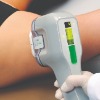Hyperhidrosis is the condition whereby an individual has abnormally increased or excessive perspiration or sweating which can occur on any part of the body, although the most commonly affected sites are the hands, feet, armpits and groin area. Hyperhidrosis usually starts in childhood or adolescence and can continue well into adulthood and beyond.
Treatments range from special antiperspirants to the more drastic surgical removal of the sweat ducts. Antiperspirants containing aluminium chloride are usually the first line of treatment, which usually involves application of the medication onto the affected area, leaving it on overnight and then washing it off in the morning. Patients are also advised to wear loose-fitting cotton clothing or moisture-wick clothing and to use absorbent sweat pads if needed.
Iontophoresis can be considered if aluminium chloride antiperspirants are found to be ineffective. Iontophoresis involves the affected area, i.e. the hands or feet being placed into shallow trays of water connected to an iontophoresis machine. A low voltage electrical current is then passed through the affected area. For the armpits, electrodes and pads are placed onto the area and then connected to the machine. Treatment occurs every few days for the first fortnight and most patients find that their excessive sweating reduces or even stops after around 4-7 treatments. Maintenance treatments are then required once a week or once a fortnight. Treatment costs between £320 and £500, but it is successful in up to 85% of patients.
Botulinum toxin (BTX-A) is also a popular choice, particularly if other treatments have failed to improve the sweating. Botulinum toxin, known by many brand names including Botox® cannot cure hyperhidrosis, but it provides temporary relief. It is injected into the skin and it works by blocking the nerves that supply the eccrine glands. This prevents them from producing sweat. Although BTX-A is typically very effective, it can be painful if it is used to treat the hands and feet unless a local anaesthetic is applied. Treatment also needs to be repeated every 3-6 months.
More recently heat energies have started to be used to treat the condition with the advent of electromagnetic (miraDry®) and laser (SweatX®) technologies to target and destroy the sweat ducts.
Surgery is also an option for treating hyperhidrosis but it is usually only considered when all other non-surgical treatments have proved ineffective. There are two types of surgery for treating hyperhidrosis. One involves removing the sweat glands from underneath the arms, while the other is a major surgery requiring a general anaesthetic, whereby the nerves that lie alongside the sympathetic ganglion chain are divided.
Do you have a question? Ask one of our experts NOWBotulinum toxin type A, know by the brand names Botox (Vistabel), Dysport (Azzalure) and Xeomin (Bocouture), is a naturally occurring protein produced by the bacterium clostridium botulinum. It is licensed as a prescription only medicine and can be used to treat wrinkles like frown lines and crow`s feet as well as hyperhidrosis or excessive sweating. As a prescription only medicine, it requires a face-to-face consultation to determine your suitability for treatment.
Hyperhidrosis is a medical condition whereby a person has abnormally increased or excessive perspiration or sweating. miraDry is the first and only device cleared by the U.S. FDA for the treatment of excessive underarm sweat.

